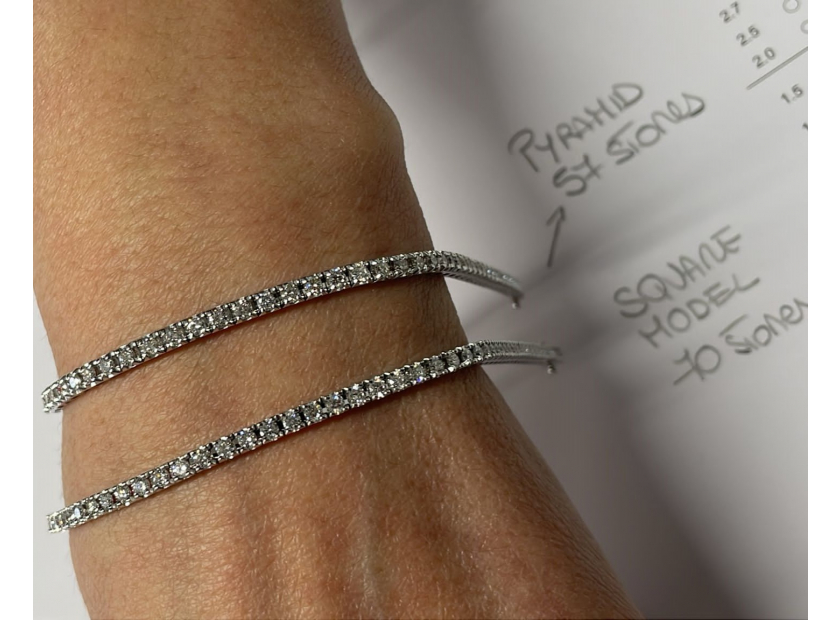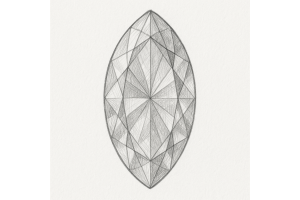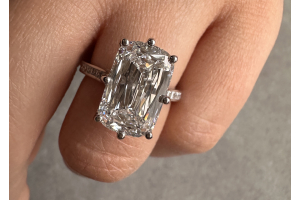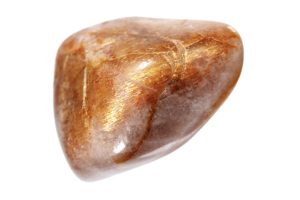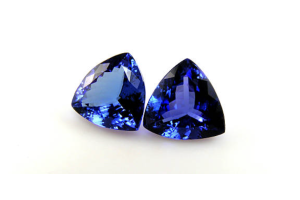USD
/
USD
/
Shipping to:
Currency:
Tennis Bracelets: A Comprehensive Guide to Types, Classic, Pyramid, and Illusion Settings
Tennis bracelets are a timeless symbol of elegance and grace, featuring a string of diamonds or gemstones that wrap seamlessly around the wrist. These bracelets are versatile, fitting for both casual and formal occasions, making them a cherished addition to any jewelry collection. While the design may appear simple, tennis bracelets come in a variety of settings that enhance the beauty and security of the gemstones. This guide delves into the different types of settings, with a particular focus on the classic, pyramid, and illusion settings, to help you choose the perfect bracelet that matches your style and preferences.
Virtually try on our tennis bracelets and compare sizes on your own wrist.
The Classic Setting: Timeless and Elegant
The classic setting for tennis bracelets is synonymous with understated elegance. In this setting, each diamond or gemstone is typically held in place by four prongs, allowing maximum light to enter and reflect off the stone, resulting in a brilliant sparkle. The classic setting is renowned for its simplicity, where the focus remains on the individual stones rather than the metalwork. This setting is a popular choice for those who appreciate traditional, clean lines and wish for their bracelet to remain a staple piece that never goes out of style.
One of the key advantages of the classic setting is its versatility. Whether paired with a cocktail dress or a casual outfit, a tennis bracelet in a classic setting seamlessly complements any attire. Additionally, this setting is highly secure, ensuring that the stones remain firmly in place, which is particularly important for a bracelet that may be worn daily.
The Pyramid Setting: Bold and Distinctive
The pyramid setting offers a bolder alternative to the classic design. In this setting, the diamonds or gemstones are arranged in a pyramidal fashion, with each stone slightly elevated above the one next to it. This unique arrangement adds depth and dimension to the bracelet, creating a more intricate and eye-catching piece. The pyramid setting is ideal for those who seek a tennis bracelet that stands out and makes a statement.
This setting not only enhances the visual appeal but also increases the bracelet's durability. The elevated design allows for more substantial metalwork, providing additional protection to the stones. While the pyramid setting is less traditional than the classic, it is perfect for individuals looking to express their distinctive style through their jewelry.
The Illusion Setting: Maximizing Sparkle
The illusion setting is a masterful design technique used to create the appearance of larger stones without the added cost. In this setting, smaller diamonds or gemstones are strategically placed within a reflective metal framework, giving the illusion of a single, larger stone. This clever arrangement maximizes the sparkle and brilliance of the bracelet, making it an excellent choice for those who desire a luxurious look at a more accessible price point.
The illusion setting is particularly popular in tennis bracelets as it enhances the overall shimmer and shine, making the bracelet appear more substantial. This setting is perfect for those who appreciate innovative designs and wish to make a statement without compromising on quality or budget.
Choosing the Right Tennis Bracelet for You
When selecting a tennis bracelet, it's essential to consider your personal style, the occasions you plan to wear it for, and your budget. Whether you prefer the timeless appeal of the classic setting, the bold statement of the pyramid setting, or the sparkling brilliance of the illusion setting, there is a tennis bracelet that perfectly suits your needs. Additionally, consider the metal type, such as platinum, white gold, or yellow gold, to further customize your bracelet to match your preferences.
Frequently Asked Questions
What is the most secure setting for a tennis bracelet?
The most secure setting for a tennis bracelet is often the classic prong setting. The prongs hold each stone firmly in place, reducing the risk of stones falling out. However, all settings can be secure if properly maintained and checked regularly by a professional jeweler.
Can the illusion setting be used with colored gemstones?
Yes, the illusion setting can be beautifully paired with colored gemstones. The reflective metal framework enhances the color and sparkle of the gemstones, making them appear larger and more vibrant.
Is the pyramid setting suitable for everyday wear?
The pyramid setting is durable and can be worn daily. Its design provides additional protection to the stones, making it a practical choice for those who want a statement piece they can wear regularly.
How do I care for my tennis bracelet?
To care for your tennis bracelet, it's important to clean it regularly with a soft cloth and mild soap solution. Avoid exposing the bracelet to harsh chemicals or extreme temperatures. Additionally, have your bracelet inspected by a jeweler annually to ensure the settings remain secure.
What metal is best for a tennis bracelet?
The choice of metal depends on your personal preference and lifestyle. Platinum is highly durable and hypoallergenic, making it an excellent choice for everyday wear. White gold offers a similar look to platinum but at a lower price point, while yellow gold provides a classic, warm appearance.



